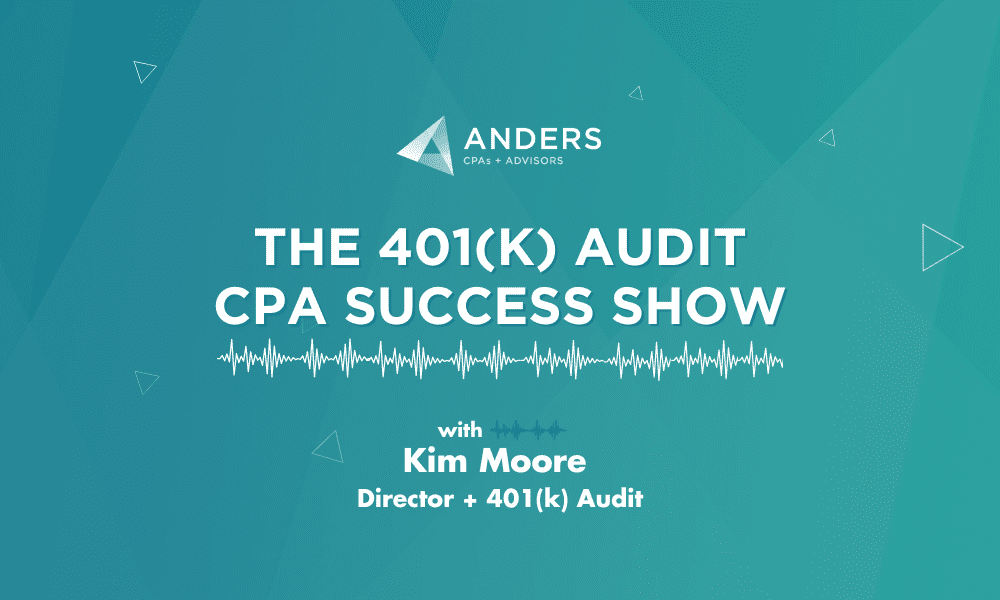As a 401(k) administrator, failing to take a proactive stance in your yearly planning can result in missed deadlines, costly late filing fees and other disruptions to the 401(k) audit process. Even with a third-party administrator (TPA), details such as investment diversity, participant education, role definition and participant satisfaction, along with other important factors, can be overlooked. Reactive 401(k) planning limits your ability to resolve issues before they become larger, costlier and potentially legal problems. 401(k) audit director and practice leader Kim Moore, CPA, discussed ways to increase proactiveness with audit and assurance manager Karen Hill, CPA, on their podcast, 401(k) Audit CPA Success Show.
Key Takeaways:
- A lack of defined roles can create confusion for new hires, muddy lines of communication with your service provider or TPA and frustrate participants
- Review plan access levels to ensure anyone who has access is currently involved in the plan and that their level of access is appropriate
- Consider creating a compliance calendar to house important deliverable dates and deadlines to ensure all tasks are completed in a timely manner
- Hiring an investment advisor can help ensure your plan offers diversified investment options for participants
- Review fees associated with the plan that are passed on to participants to make sure they’re not unreasonably high
Transitioning from Reactive to Proactive 401(k) Planning
You may already take steps to monitor your 401(k) plan or it may be managed externally by a third-party administrator, but taking time at the beginning of the year to review designated roles, create a compliance calendar, educate participants, measure participant satisfaction, increase monitoring, improve investment diversity and investigate plan fees impacting participants.
Relying solely on your TPA can open you up to mistakes that are difficult to resolve months or even years later. For instance, if roles aren’t properly designated, you could potentially run into a scenario where the previous communication point person for your TPA has left the company, but no one ever updated the TPA. So for months, possibly even years, your TPA has been emailing an account that’s no longer in service and your company has missed several opportunities to correct documents before they’re filed. Now your company, and perhaps you personally, are now responsible for the consequences.
Completing the following actions can help keep your 401(k) audit moving on schedule while potentially protecting you and your company from costly fines and adverse legal action.
Define Key Roles within the Plan and Monitor Access
Make sure that all roles regarding plan compliance are designated and granted an appropriate amount of access within the plan. Determine who is responsible for the following tasks to create a more seamless process:
- Who files the Form 5500?
- Who prepares the census?
- Who responds to issues brought up in compliance testing?
- Who responds to inquiries from participants and beneficiaries?
- Who responds to inquiries from the Department of Labor (DOL) or the IRS?
- Who serves as the point person in the case of a DOL audit?
The final point listed above is especially critical. Without a response from someone at your company, you can be hit with an automatic fine. Because of regulations set by Congress, the DOL and the IRS aren’t able to offer recourse or other ways to avoid the fine. Inform new employees, and remind veteran employees, of their responsibilities immediately to make sure they’re covering these important tasks.
Be sure to regularly review plan access to determine that anyone who has access is a current employee. Sometimes employees who have left the company never had their access to the plan revoked. You should also take this time to review access levels to make sure they’re appropriate. For instance, auditors are regularly granted access to your systems, but they don’t require administrative-level access to complete their work. Understand what levels of access are necessary for each role and what each level of access allows a user to do.
Create a Compliance Calendar
With so many tasks and deadlines to track throughout the year, a compliance calendar can help you monitor key dates so you can avoid fees associated with late filings. Also include your payroll system in the calendar to be sure you don’t miss important dates or fail to implement updates. Payroll changes can impact 401(k) planning, so be sure to review payroll updates carefully, especially at the beginning of the year when most changes in payroll happen.
Some tasks may need a follow-up. For instance, if your compliance testing comes back with corrections, those corrections must be made by March 15th to avoid excise tax. Each year, a new calendar will need to be created. Resist the urge to roll over the same calendar from the year before because new activities are added and removed each year. Take time to review the previous year’s compliance calendar as well. Were there any tasks that weren’t completed? Were you constantly running behind and playing catch-up? You may want to reconsider how much time you’ve allotted to complete tasks.
Educate Participants and Yourself on your 401(k) Plan
If your goal is to increase participation levels in the plan, a good start would be educating employees about the plan. Tell them how it works, lead educational sessions with employees to inform them about changes you’re going to make for the plan. These sessions can be added to your compliance calendar. Make sure you’re also taking time to keep yourself educated about changes impacting 401(k) planning, such as the recent implementation of the SECURE Act 2.0.
Measure Participant Satisfaction
Ask participants for feedback on the plan. An effective way may be to release a survey or even going person to person. You may consider including participants or employees in investment committees or your 401k plan committee. Create a space where participants can come to you with complaints about the plan, even if you don’t think there’s anything you can do about it. Once the complaint is known to you, you may be able to find a workable solution anyway.
Monitor Transactions and Don’t Forget Payroll
Keep an eye on transactions in the plan, especially distributions, even if a TPA generally performs monitoring for your company. Distributions are generally where fraud occurs and as the plan administrator, you bear a fiduciary duty to your participants to safeguard their funds. Monitor payroll as well, because that’s an area that’s susceptible to fraud, both purposeful and accidental.
Review Your Investment Lineup for Diversity
Neglecting to offer a diverse range of investment options can leave your company vulnerable to a lawsuit from an employee or a class action suit from a group of employees. If you review your investment offerings and determine that it’s varied, consider comparing how these investments perform against peer investments. It has to make sense, though. You could compare a bond fund to another bond fund or bond index, but not to an equity fund. Be sure to document the actions you’ve taken to ensure a diverse range of investment options are available to participants. Hiring an investment advisor can also help you navigate the ever-changing investment landscape. Document any discussions you have with the advisor and make changes to the investments as needed based on those discussions.
Examine Fees Associated with Your Plan
If the company is paying the fees associated with the plan as a whole, that’s not an issue. You can have a high-end plan with a lot of fees as long as your company is paying it and it’s not being charged to the participants. If those fees are passed along to the participants and they feel that the fees are eating into the money they are investing, that could lead to a lawsuit. An investment advisor or your service provider should be able to help you with benchmarking.
If you need an audit for your 401(k) plan, learn more about our 6-phase 401(k) audit process or request a free 401(k) audit consultation below.
Watch the 401(k) Audit CPA Success Show: 7 Tips to Become a Proactive Plan Administrator on YouTube and subscribe on Spotify or Apple Podcasts and let us know what you think by rating and reviewing.


